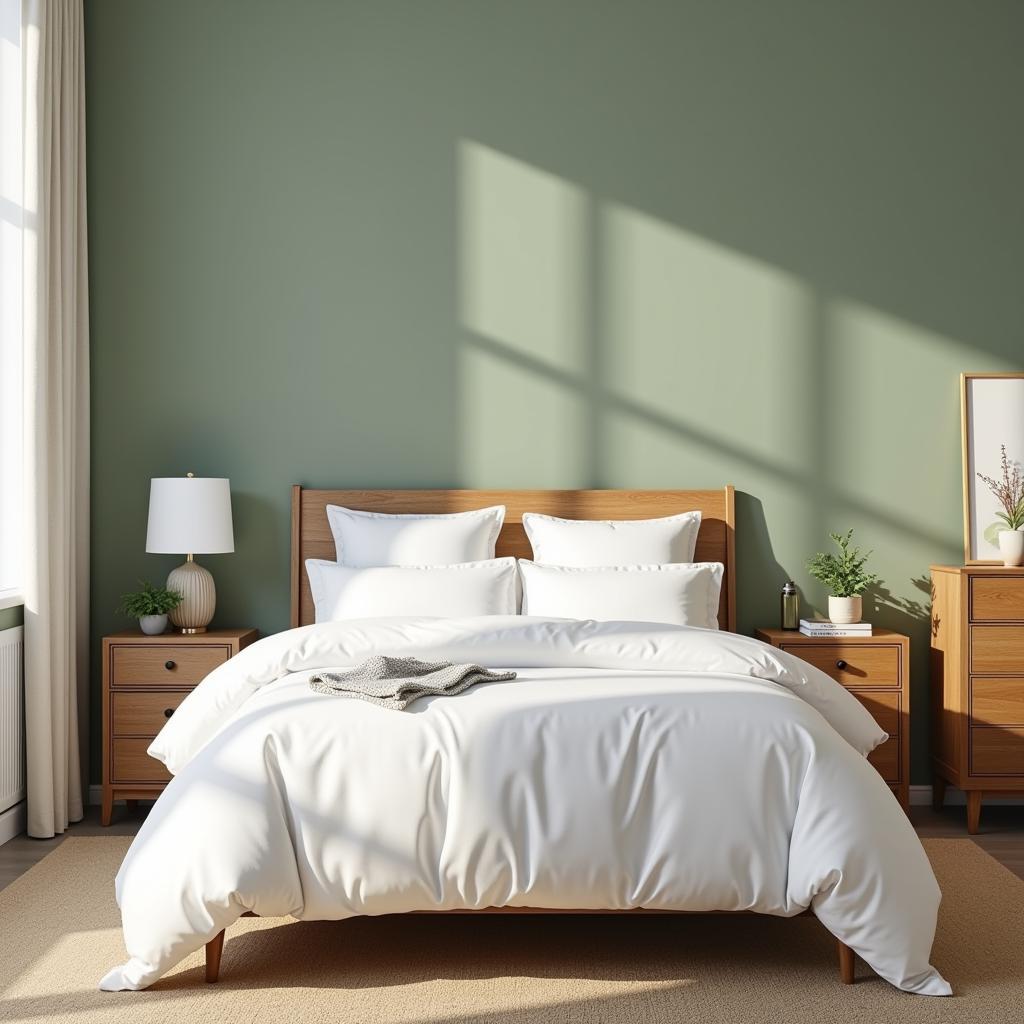Choosing the right color for your bedroom is a big decision. It’s the space where you start and end your day, so you want it to be a haven of peace and relaxation. But with endless color options, it can feel overwhelming. Don’t worry, we’re here to guide you through the process.
Understanding the Impact of Color
Colors have a powerful psychological effect on our mood and well-being. Understanding these effects can help you create a bedroom ambiance that aligns with your desired atmosphere.
-
Warm Colors: Shades like red, orange, and yellow evoke feelings of energy, passion, and warmth. While they can add a cozy touch, it’s best to use them sparingly in the bedroom.
-
Cool Colors: Blue, green, and purple are associated with calmness, serenity, and relaxation, making them popular choices for bedrooms.
-
Neutral Colors: White, gray, beige, and brown create a sense of balance, sophistication, and timelessness. They serve as an excellent backdrop for adding pops of color through decor and accessories.
 Neutral Bedroom Ideas
Neutral Bedroom Ideas
Factors to Consider When Choosing a Bedroom Color
Before diving into specific color recommendations, consider these essential factors:
-
Natural Light: Assess the amount of natural light your bedroom receives. Light colors can make a room feel brighter and more spacious, while darker colors can create a cozier ambiance in well-lit spaces.
-
Room Size: Light colors can make a small bedroom appear larger, while darker colors can make a large bedroom feel more intimate.
-
Personal Style: Your bedroom should reflect your personality and taste. If you prefer a minimalist aesthetic, opt for neutral colors. If you love bold statements, embrace vibrant hues.
 Bedroom Color Palette
Bedroom Color Palette
Popular Bedroom Color Ideas
Here are some popular bedroom color ideas to inspire you:
1. Serene Blues
Blue is a classic choice for bedrooms, promoting tranquility and a good night’s sleep.
-
Sky Blue: Evokes feelings of peace and openness.
-
Navy Blue: Adds a touch of sophistication and drama.
-
Teal: Combines the calmness of blue with the refreshing energy of green.
Expert Insight: “When using blue in the bedroom, consider incorporating different shades and textures to create depth and visual interest,” says renowned interior designer, Emily Carter.
2. Tranquil Greens
Green is associated with nature, renewal, and harmony, making it a soothing choice for bedrooms.
-
Sage Green: Creates a sense of calmness and serenity.
-
Olive Green: Adds a touch of warmth and earthiness.
-
Mint Green: Offers a refreshing and airy feel.
 Green Bedroom Design
Green Bedroom Design
3. Relaxing Neutrals
Neutral colors provide a timeless and versatile backdrop for any bedroom style.
-
Warm White: Creates a clean and inviting atmosphere.
-
Light Gray: Offers a sophisticated and contemporary feel.
-
Beige: Adds warmth and a touch of elegance.
-
Greige: A blend of gray and beige, offering the best of both worlds.
You might also like: how to pick a carpet color
4. Romantic Hues
For a touch of romance and intimacy, consider these color options:
-
Blush Pink: Evokes feelings of love and tenderness.
-
Lavender: Promotes relaxation and calmness.
-
Pale Yellow: Adds a touch of warmth and cheerfulness.
5. Bold and Dramatic Colors
If you prefer a statement bedroom, don’t shy away from bold and dramatic colors.
-
Charcoal Gray: Creates a moody and sophisticated ambiance.
-
Deep Emerald Green: Adds a touch of luxury and opulence.
-
Dark Blue: Evokes feelings of depth and tranquility.
You might also like: what colors match with salmon
Tips for Incorporating Color into Your Bedroom
Here are some additional tips for incorporating color into your bedroom:
-
Use the 60-30-10 Rule: This classic design principle suggests using 60% of a dominant color, 30% of a secondary color, and 10% of an accent color.
-
Create an Accent Wall: Highlight a focal point in your bedroom, such as the headboard wall, with a different color or wallpaper.
-
Incorporate Color Through Textiles: Add pops of color through bedding, curtains, rugs, and throw pillows.
You might also like: [what colors go with sky blue](https://colorbox.com.vn/what colors-go-with-sky-blue/)
Conclusion
Choosing the right color for your bedroom is a personal journey. By understanding the impact of color, considering your preferences, and exploring different options, you can create a space that reflects your style and promotes rest and relaxation. Remember, your bedroom should be your sanctuary, a place where you can unwind and recharge.
FAQs
Q: What is the most relaxing color for a bedroom?
A: Blue is often considered the most relaxing color due to its association with calmness and tranquility.
Q: Can I use bright colors in a small bedroom?
A: While light colors are generally recommended for small bedrooms to make them appear larger, you can incorporate pops of bright colors through accents and decor.
Q: How can I test out paint colors before committing?
A: Paint swatches on a small section of your bedroom wall and observe them at different times of the day to see how the light affects the colors.
Q: Can I mix and match different color palettes in my bedroom?
A: Yes, you can create a cohesive and visually appealing look by using colors from the same color family or by choosing complementary color schemes.
You might also like: de que color pintar casa
Q: How often should I repaint my bedroom?
A: It’s generally recommended to repaint your bedroom every 3-5 years or whenever you feel like it needs a refresh.
If you need support, please contact us via phone: 0373298888, email: [email protected] Or visit us at: 86 Cầu Giấy, Hà Nội. We have a 24/7 customer service team.
